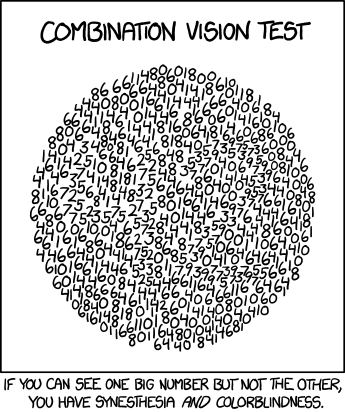

Looking for a specific word or phrase in a lengthy list or article can also be facilitated with grapheme color synesthesia, as well as when it comes to memorization. However, the number ‘6’ and the word ‘six’ may be perceived differently, if the three letters ‘s’, ‘i’, and ‘x’ are associated with different colors from each other, and from the number ‘6’.Īn advantage to having grapheme color synesthesia is when solving a word-search puzzle or crossword puzzle- instead of picking out letters and words, a synesthete can look for certain colors for help. blue is always paired with 6) these associations do not change over time. Although there is variety among individuals, there is consistency within an individual, so the same color is always paired with the same number (i.e. Another important point is that there is no universal association of a number and letter to a color among synesthetes- they each have different pairings. The most common type of synesthesia is grapheme color synesthesia, in which numbers and letters are perceived as different colors. By extension, most people with synesthesia are not aware that they do have synesthesia, as they believe that others have the same experiences they do, or are afraid to stand out and therefore not mention it. But for those with synesthesia, this is their perception of the world. The idea of being able to perceive letters and numbers in different colors, to hear colors, or to touch smells seems perhaps impossible, simply because their perception of the world is different. It is important to note that synesthesia is not a disease or disorder, but rather a phenomenon that occurs.įor those who do not have synesthesia, the concept may be rather overwhelming or inconceivable. While this appears to be a rather broad range, this uncertainty is generated by the challenges in diagnosing synesthesia, as will be discussed below.

Synesthesia, the neurological phenomenon in which the stimulation of a sensory or cognitive pathway results in automatic experiences in another sensory or cognitive pathway, is found roughly in one to twenty five percent of the population. These associations are ingrained into us, but it is not always the case. We grow up learning about the body parts associated with these senses- eyes, nose, ears, tongue, and skin, respectively. No offensive language, trolling, insults or provocation.Īny NSFW posts (or comments) must be synesthesia-related and tagged NSFW.We grow up learning about the five senses- sight, smell, sound, taste, and touch. “Is This Synesthesia” posts are welcome! No obligation, but before posting you might like to try out the new Synesthesia Finder or look at this alphabetical list of types of synesthesia and other related phenomena: you might be surprised to find exactly what you experience. There are many different types of synesthesia and we discuss all of them on this sub. Probably around 4% of the world’s population are synesthetes: people with a neurological trait that enables them to enjoy additional perceptions in response to certain sensory or conceptual stimuli such as hearing sounds or music, tasting food or thinking of numbers or letters.


 0 kommentar(er)
0 kommentar(er)
